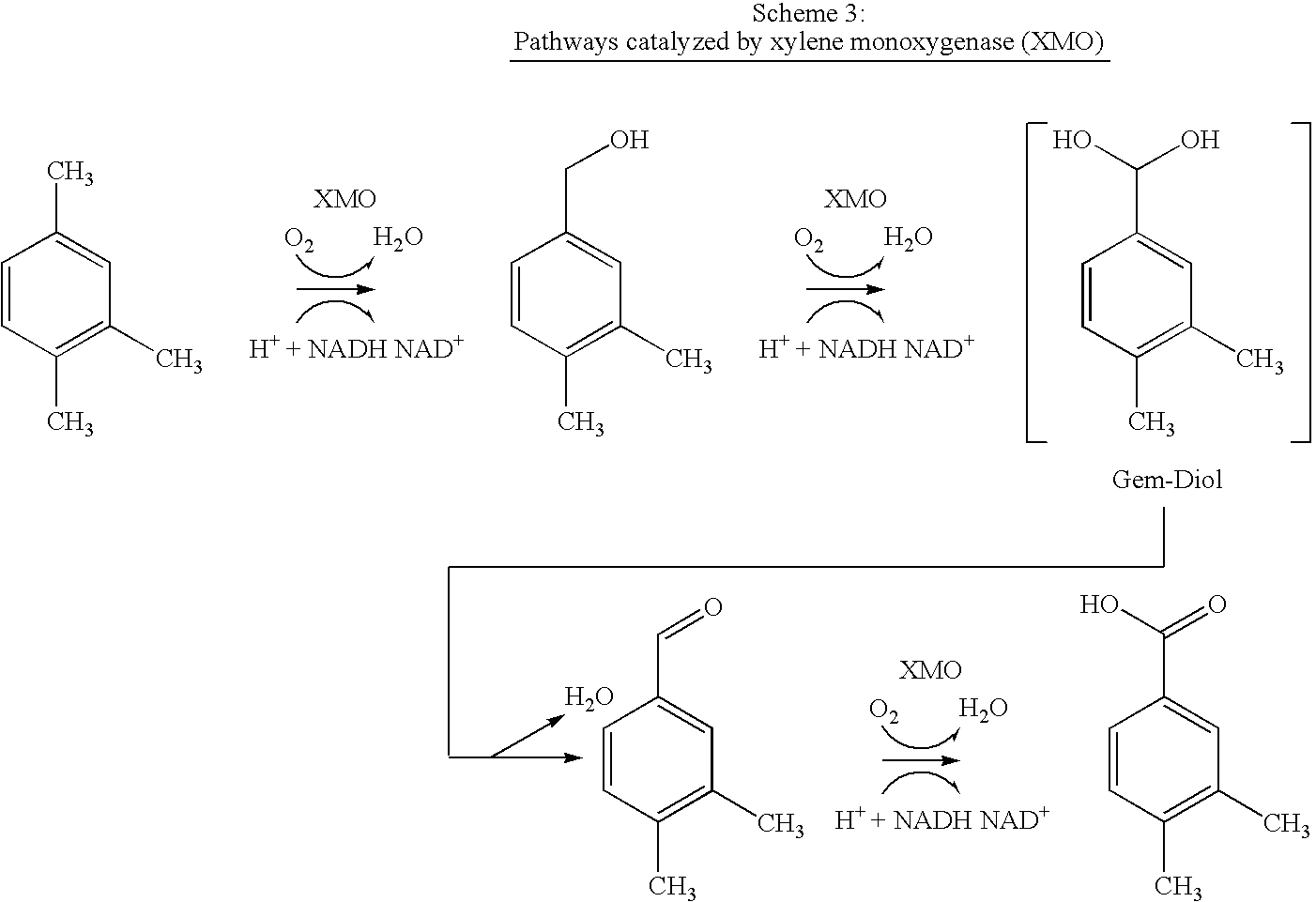Method for the oxidation of aromatic compounds
a technology of aromatic compounds and oxidation methods, which is applied in the field of improved biocatalytic process for the oxidation of aromatic compounds, can solve the problems of difficult chemical synthesis of 3,4-dimethylbenzaldehyde by chemical synthesis, the difficulty of one methyl group or the isolation of product mixtures,
- Summary
- Abstract
- Description
- Claims
- Application Information
AI Technical Summary
Benefits of technology
Problems solved by technology
Method used
Image
Examples
experiment 1.1
[0149] Fermentation With Feed Solution I With Yeast Extract
[0150] The biotransformation was carried out using the above-described fermentation process. Before the inoculation, the medium was supplemented with 0.5% (w / v) glucose. After the batch, the biomass reached a cell dry weight of 3.1 g / l. The feed rate was 10 g / h at the beginning of the fed-batch culture, corresponding to a glucose feed rate of 4.5 g / h. To prevent unduly severe glucose limitation, the feed rate was increased stepwise. The aeration rate was increased from 1 l / min to 1.7 l / min after 3 hours to circumvent oxygen limitation.
[0151] FIG. 2 shows the data of the acetic acid and glucose concentrations and of the cell dry weight. After reaching the stationary phase, the cell dry weight was 19 g / l. When the bacterial growth stopped after 8 hours, the acetic acid concentration was 10 g / l, while the glucose concentration was 9 g / l.
[0152] FIG. 3 shows the changes in the pseudocumene, 3,4-dimethylbenzaldehyde (DBAlk), 3,4 ...
experiment 1.2
[0155] Fermentation With Feed Solution I Without Yeast Extract
[0156] The purpose of this fermentation was to study the effects of feed solution I without yeast extract on the biotransformation.
[0157] FIG. 4a shows the courses of the glucose and acetic acid concentrations and of the cell dry weight. Prior to inoculation, the glucose concentration in the medium amounted to 0.5% (w / v). At the beginning of the fed-batch culture, the cell dry weight concentration was 3 g / l. The feed solution without yeast extract was fed at a constant rate of 10 g / h. This corresponds to a glucose feed rate of 4.5 g / h. After 7 hours, the stirring rate was increased from 2000 rpm to 2500 rpm to circumvent oxygen limitation (DOT>10%).
[0158] Even low glucose concentrations resulted in the formation of acetic acid. Thus, the acetic acid concentration was kept constant at a value of 1 g / l by glucose limitation. When the glucose concentration in the medium was increased, the acetic acid concentration increased...
experiment 1.3
[0162] Fermentation With Increased Substrate Concentration
[0163] It has been found in earlier experiments that an increase in the substrate concentration has a positive effect on the formation of 3,4-dimethylbenzaldehyde. Thus, the substrate concentration was increased from 1.6% (v / v) to 3.1% (v / v). Furthermore, it was attempted to keep the glucose concentration, and thus also the acetic acid concentration in the medium, down. In the 2.sup.nd part of the biotransformation, 15 hours after the beginning of the fed batch culture, the effect of a simultaneously occurring severe glucose and oxygen limitation was studied. Thus, the feed supply and the aeration were reduced simultaneously.
[0164] 0.5% (w / v) of glucose was added to the medium prior to inoculation. Starting from a cell dry weight of 3 g / l, the biomass increased during the fed batch up to a concentration of 27 g / l. At the beginning of the fed batch culture, feed solution with yeast extract was fed at a rate of 10 g / h (glucose...
PUM
| Property | Measurement | Unit |
|---|---|---|
| boiling point | aaaaa | aaaaa |
| boiling point | aaaaa | aaaaa |
| Partition coefficient | aaaaa | aaaaa |
Abstract
Description
Claims
Application Information
 Login to View More
Login to View More - R&D
- Intellectual Property
- Life Sciences
- Materials
- Tech Scout
- Unparalleled Data Quality
- Higher Quality Content
- 60% Fewer Hallucinations
Browse by: Latest US Patents, China's latest patents, Technical Efficacy Thesaurus, Application Domain, Technology Topic, Popular Technical Reports.
© 2025 PatSnap. All rights reserved.Legal|Privacy policy|Modern Slavery Act Transparency Statement|Sitemap|About US| Contact US: help@patsnap.com



